Here is the rare G Zildjian cymbal stamp, and my brainstorm of a possible solution to the G Zildjian cymbals mystery. Only a few of these cymbals are known to exist. If you know of a cymbal with this stamp, please contact me or leave a comment!
G Zildjian (1910-1920s?)
 |
Fabian Duehrssen, a drummer from Germany purchased a G Zildjian cymbal sometime in May 2013. He says, “I got it from a drummer in a small town between Stuttargt and Nuremberg. All he could tell me about the cymbal is that he bought it from another drummer at a music festival years ago.” |
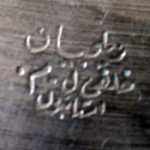 |
Here is Fabian’s photo of the Turkish Arabic portion of they cymbal. |
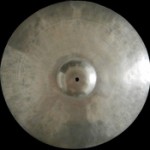 |
Fabian reports that the cymbal is 15.4″ in diameter and he claims that it weight 940 grams, though in his youtube video of the cymbal it seems heavier. Thank you Fabian for sharing this cymbal with the webpage. |
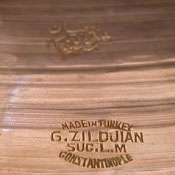 |
– – – – Made in Turkey G. Zildjian Suc L. M. Constantinople |
 |
Below, I argue that the relatively unknown “G Zildjian” cymbals may have been produced by Kerope Zildjian’s son-in-law Gabriel in Suç, Albania sometime between 1910 and 1928. The Zildjian family tree (left) shows that K Zildjian had several daughters, and the cymbal bronze secret was given to his son-in-law Gabriel Dulgaryian (Pinksterboer 1992, p. 140). When Kerope died in 1909, Aram Zildjian was the only other man with the secret. After Gabriel’s death in 1928, hid son Mikhail continued making K Zildjian cymbals in Constantinople. When the Turkish government banned Armenian-sounding names in 1935, he changed his last name to Zilçan. Gabriel’s son ran the Zildjian cymbal factory in Istanbul until it’s close in 1977. |
 |
The cymbals read “SUC L.M.” – I think the L refers to the nearby Municipality of Lis and the M refers to the District of Mat? In this sense it would be similar to “Washington D.C.” and it stands to reason that Suç residents may have used Lis, Mat as the nearest postal delivery/shipping center, given that photos of Suç reveal a tiny rural farm town. |
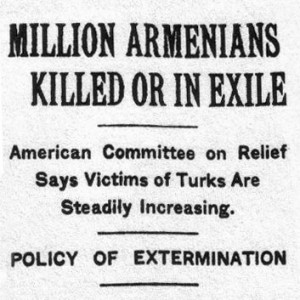 |
The Ottoman Empire entered World War I on the side of the Central Powers on November 2, 1914. The worst years of the Armenian Genocide lasted between 1914-18. It is estimated that between 600,000 and 1,500,000 Armenians were killed during these years. Read the wikipedia page – it was a total tragedy.
The Zildjians were a very visible family of Armenians in the heart of the Ottoman Empire. The Sultan Abdülaziz had helped the Zildjian family in 1868 (Pinksterboer 1992, p. 141), but after a brief struggle for democracy, Abdul Hamid II took over in 1876 and was increasingly pitted against reformers, including Armenians, while outside forces occupied Ottoman territory. |
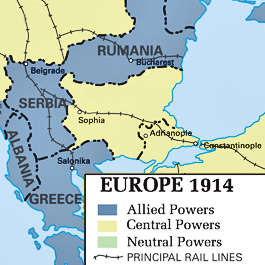 |
Q: Why was Aram Zildjian in Bucharest, Rumania during the 1910s? – – A: The same reason that his cousin-in-law was in Albanian farm country. Being a known-Armenian in Constantinople during 1915 would have been like being openly Jewish in Berlin during 1940. |
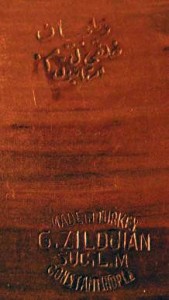 |
Two other “G Zildjian – Constantinople” stamps posted online: http://photos.imageevent.com/drumaholic/trademarks/G%20Zildjian%20stamp.jpg http://photos.imageevent.com/drumaholic/trademarks/G%20Zildjian%20TMII%20k_1.jpg – – – The cymbal stamp reads “Made in Turkey” and “Constantinople” because that’s what the markets wanted the Zildjians to provide. Even today, people are selling “Constantinople” cymbals out of Quincy, Massachusetts. Aram Zildjian’s cymbals from Bucharest also include “Constantinople” in the stamp. – – ______________ References Pinksterboer, Hugo. 1992. The Cymbal Book. Milwaukee: Hal Leonard Corporation. |
I’ll send you some better soundfiles as soon as I can record some.
By the way, Zildjian responded yesterday:
Cheers,
Chet
http://www.drummagazine.com/gear/post/the-romanian-a-zildjians-missing-link/